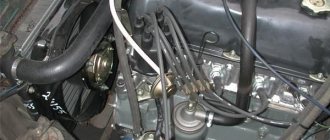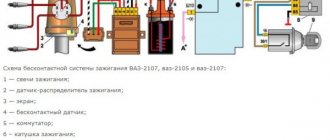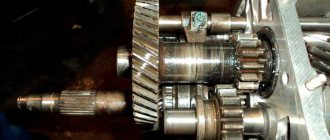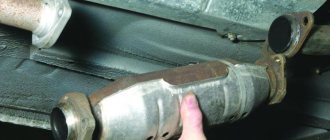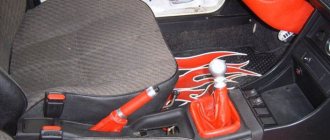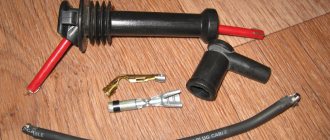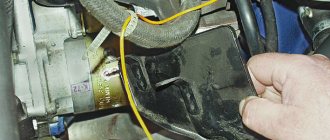Owners of cars produced by the Volzhsky Automobile Series must definitely master the procedure for carrying out some settings. In particular, every driver should know how to adjust VAZ valves.
Why do you need to adjust VAZ valves?
The laws of physics certainly apply to every part of a car. Thermal expansion of bodies is a property of metals that must be taken into account when creating a motor. When it comes to adjusting the clearance between the valve lever and the camshaft cam, few people understand why it is needed.
During operation, the valve and other parts become very hot, causing expansion. In the absence of a thermal gap, the end of the neck, resting against the pusher, will leave the socket slightly open, which will lead to loss of power, excessive fuel consumption and disruption of all settings of the gas distribution mechanism.
If the gap is large, the valve head will not be able to fully open the cylinder for exhaust or fuel mixture, which will also degrade performance. During the research, it was found that the valve neck on the VAZ 2107 and other parts in contact change their size by 0.15 mm. This is what determines the thickness of the probe that is used for adjustment.
When is mandatory valve adjustment required on a VAZ?
Quite often, drivers, especially inexperienced ones, postpone technical inspections and some adjustments, citing the fact that the engine is running stably. All engine parts wear out, they are affected by constant temperature changes, and therefore there is a need to regulate thermal clearances.
You should start adjusting the valves in the following cases: any, even minor, timing belt repair; the appearance of characteristic noise in the area of the cylinder head cover; mileage over 15 thousand km. after the last regulation; loss of engine power and increased fuel consumption.
New domestic and foreign cars deprive their owners of the opportunity to carry out this procedure, thanks to the presence of hydraulic compensators, but everyone who drives a VAZ classic must definitely master the procedure for adjusting the thermal clearances of the valves.
Adjusting the valves of the VAZ 2107 - preparatory stage
Any work in the garage, and especially such an important procedure as adjusting the 2107 valves, must begin with preparation. Performing simple actions, preparing materials and tools - everything is aimed at ensuring that the goal is achieved. Preparations are usually divided into two stages:
- vehicle preparation;
- preparation of tools and devices.
The golden rule of any self-respecting auto mechanic is to wash the car before repairing. In addition to washing the outside of the body, you should definitely clean the engine compartment. It is pleasant to work with a clean machine, and accumulated dirt and dust will not be able to enter the motor cavity when the head cover is opened.
Next you need to do the following:
- the car is installed on a flat, well-lit area;
- the car wheels are secured with the parking brake, the ignition is turned off, the key is removed from the lock;
- in the absence of sufficient natural or standard garage lighting, it is necessary to install additional light sources;
- prepare a set of wrenches, a feeler gauge 0.15 mm thick;
- Remove the air filter housing and cylinder head cover.
The valves 2107 can now be adjusted.
The procedure for adjusting VAZ 2107 valves - step-by-step instructions
When everything is ready, you can begin direct regulation. Before mastering the procedure, you should understand the structure of the gas distribution mechanism and find out where the thermal gap is located that should be adjusted. The valves on the VAZ 2107, in fact, like on the vast majority of automobile engines, are located at the top, that is, the valve closes the hole located above the piston.
For each cylinder there are two valves: an inlet for supplying a combustible mixture and an outlet for removing exhaust gases. The clearance in the cylinder head opens due to the action of the camshaft cams. The camshaft is located above the valves and has its own eccentric cam for each of them, which transmits movement to the valve stem through a special lever. The gap between the cam (the point opposite the eccentric) and the lever should be adjusted.
Adjusting the valves of the VAZ 21074 does not differ from the adjustment of the “07” model and begins with the piston in the 4th cylinder being set to top dead center (TDC), which corresponds to the compression stroke. At this point both valves will be closed. To do this, using a 38mm wrench, rotate the crankshaft until the mark on the camshaft sprocket meets the mark on the bearing housing.
Now you need to take two open-end wrenches for “13” and “17”, as well as a dipstick. The valves are regulated in accordance with a certain order, for which they are numbered from the front of the engine.
The VAZ 2107 valves are adjusted as follows:
- insert the probe between the cam and the lever of the 8th and 6th valves alternately;
- if the probe passes with little effort, then the gap corresponds to the norm;
- unimpeded passage or sticking of the probe indicates the need for adjustment;
- fix the head of the adjusting bolt with a wrench set to “13”, release the lock nut using a wrench set to “17” and turn the bolt in the desired direction to increase or decrease the gap, tighten the lock nut and check the gap.
It is necessary to proceed in this way with each valve, turning the crankshaft 180° from the previous point each time. This operation corresponds to turning the camshaft by 90°. With each turn it is necessary to adjust the following numbered valves:
- 180° - 4th and 7th;
- 360° - 1st and 3rd;
- 540° - 5th and 2nd.
The procedure for adjusting the valves of the VAZ 2107 must be strictly followed, otherwise the settings of the gas distribution system can be completely disrupted. After each valve has been checked, it is necessary to turn the crankshaft several times and check the clearances again. It is necessary to ensure that the probe enters each of the gaps with absolutely the same force.
Why do valves need adjustment?
The gas distribution system in a car, including VAZ classics, is a mechanism that requires fairly precise adjustment: the valves must open and close at a certain moment, no later and no earlier.
To regulate this timeliness of valve operation, engine designers have incorporated an adjustment system.
If you do not carry out the necessary adjustment work, this can lead to the following consequences:
- a decrease in engine power due to a decrease in the tightness of the combustion chamber due to slightly open valves,
- engine overheating,
- burnout of the valves themselves due to the possible entry of hot gases into the cavities between the valve and its seat.
Preliminary preparation
Before you start adjusting and tuning, it is worth tensioning the chain to an acceptable level if it is loose. There is a corresponding device under the hood for this purpose.
After removing the valve covers, you need to check and set the marks in the correct positions. There is a lower groove on the crankshaft pulley and a small boss on the cover in front of the cylinder block, as well as a depression on the top of the camshaft sprocket and a boss on the camshaft bed.
We recommend: How to properly remove the interior light bulb with your own hands?
Adjusting valves VAZ 2107
To adjust the valves on a carburetor engine, you will need to remove the air filter housing and disconnect the carburetor throttle actuator. On an injection engine, you just need to disconnect and put aside all interfering pipes and wires. Unscrew the bolts securing the valve cover and remove it.
Next, if the engine is carburetor and equipped with a ratchet, insert the manual engine start handle into it and use it to turn the crankshaft.
On an injection engine, using a special 38mm wrench, turn the crankshaft by the pulley bolt to the top dead center position of the first cylinder. If there is no such key, support the front wheels of the car, turn off the handbrake, use a jack to lift one rear wheel and engage fifth gear.
The wheel will rotate easily on it, and so will the engine crankshaft. While rotating the wheel, set the TDC mark on the crankshaft pulley or on the camshaft gear.
Next, use a 0.15 mm wide feeler gauge to check the gap on closed valves according to the following scheme:
ATTENTION! Thermal clearances are checked on a cold engine!
It is also possible to determine whether the valve is closed or not without a diagram. To do this, you can reach under the kick pedal with your hand and feel the position of the camshaft cam relative to the valve pusher. It should be directed towards him with the back of the head .
When checking the clearance, the feeler gauge should fit between the camshaft and the rocker with slight tension. If the probe passes too easily or, on the contrary, does not pass at all, then this valve must be adjusted.
To do this, hold the adjusting bolt with a 13 wrench (a), release the locknut with a 17 wrench (b) and, rotating it, achieve such a gap so that the dipstick “bites” slightly, but it can be inserted and pulled back out. Having set the gap, hold the adjusting bolt and tighten the locknut.
After adjustment, you need to recheck the gap. We repeat the same operation for all valves.
After successful adjustment, we assemble everything in the reverse order and at this point the valve adjustment can be considered complete.
Valve stem seals
While adjusting the valves, it is quite possible that you had no idea that you were next to another very important element of the gas distribution mechanism - the valve stem seals.
Oil scraper seals are located on the valve stems of the gas distribution mechanism
Purpose of valve stem seals
While the engine is running, the camshaft, rocker arms, valve springs and valve tops operate in an oil mist. Oil is deposited on all parts and mechanisms located under the valve cover. Naturally, it also ends up on the top of the valves, called stems.
Under the influence of gravity, the oil will tend to flow into the combustion chamber. As you know, it shouldn't be there. Oil seals are designed to prevent oil from flowing down the valve stem into the engine combustion chamber.
Engine malfunctions associated with worn caps
The sole purpose of the oil seal is to prevent oil from draining into the engine combustion chamber. Over time, the rubber of this element loses its functions and is destroyed under the influence of an aggressive environment. This leads to the penetration of oil into the air-fuel mixture, where it burns successfully.
A working engine should have oil consumption of about 0.2 - 0.3 liters per 10 thousand kilometers. With worn valve stem seals, it can reach one liter per thousand kilometers.
Oil burning in the cylinders:
- clogs and destroys catalytic converters and particulate filters (devices that reduce the content of harmful substances in exhaust gases), which themselves are very expensive;
- causes overheating and premature failure of engine exhaust valves;
- greatly increases exhaust smoke;
- increases the risk of engine oil starvation due to lack of oil.
The service life of valve stem seals on domestic cars fluctuates around 80 thousand kilometers. This parameter very much depends on the quality of the caps themselves and the oil used.
What components are best to use?
Today, the greatest trust among car enthusiasts and mechanics is in the products of such well-known brands as Corteco and Elring - these brands have proven themselves to be the best in the production of gaskets, oil seals, seals, and valve stem seals.
There are products from domestic manufacturers on the market. Their quality varies greatly, but nevertheless does not reach the quality of the products of leading companies.
How to change valve stem seals
The topic of replacing valve stem seals is extensive and worthy of a separate article. Briefly it is done like this.
- Remove the valve cover.
- Remove the camshaft star. To remove the camshaft star, you need to unscrew the bolt holding it with a lock washer
- Remove the camshaft from its beds. To remove the camshaft, you need to unscrew the bolts securing its bearing housing
- Support the valves with a tin rod through the spark plug well. To prevent the valves from falling down, they need to be supported with a tin rod
- Dehydrate the valve. Compress the valve spring and remove the crackers from the groove.
- Replace the valve stem seal. The old valve stem seal is removed using two screwdrivers
Work order
The VAZ 2107 injector itself is installed on a flat, well-lit area, the ignition is turned off, and the parking brake is applied.
It is recommended that a novice car enthusiast thoroughly understand the structure of the gas distribution mechanism, as well as clarify the location of the thermal gap - the one that requires adjustment.
Adjusting valves VAZ 2107
Before proceeding directly with the adjustment, you need to bring the crankshaft into the desired position. To do this you need to do the following:
- The cover is removed from the cylinder head. To do this, use a 10mm wrench to unscrew 8 nuts. It is recommended to replace the old gasket. After removing the cover, access to the valve adjustment screws opens.
- Then the timing chain tension is checked and, if necessary, the chain should be tightened. The mark on the timing parts is placed at the beginning of the procedure and at the end.
- Remove the cover from the ignition distributor.
- Using a 38 key, the piston of the fourth cylinder is set to the position at top dead center (until the mark on the sprocket and on the cylinder head align). Twisting the crankshaft does not provide for its return - this should be taken into account. Therefore, when twisting, the circle will need to be twisted again. There should be a maximum gap between the cams and levers.
- In this position, the intake and exhaust valves of the fourth cylinder, the exhaust valve of the second cylinder and the intake valve of the third cylinder are adjusted.
- A feeler gauge is inserted between the valve cam and the lever. If the feeler gauge enters with little effort and moves freely, then the gap is normal. If the dipstick fits tightly or, conversely, too loosely, it means that the injector on the VAZ 2107 car engine requires valve adjustment.
If you don’t have a 38 key, the crankshaft can be moved to the desired position in two ways. The first method is quite complicated, it requires a lot of space and some physical effort. It consists in the fact that the VAZ 2107 car is manually pushed until the marks on the sprocket and on the cylinder head coincide.
For the second method, you will need a jack and one assistant. While one person turns the steering wheel, the second will monitor the level of the camshaft and crankshaft.
Some attention should also be paid to the timing chain. You can check its tension with your hands - if the deflection does not exceed 10 mm, the timing belt tension is considered normal.
A brief excursion into history
The VAZ 2107 was not always fuel-injected. At first, these cars were equipped with conventional carburetors. And the car began to be equipped with a forced fuel injection system only in 2006. The reason is simple: the automaker tried to fit its cars to the standard now known as Euro 2, and this required changing a number of characteristics of the car. The main advantage of replacing the carburetor system with an electronic system was that in the injection version there was no need to fine-tune the injection. That is, there was no “swimming” at idle speed for injection cars. But there were also disadvantages. For example, increased fuel requirements. The catalyst for the injection “sevens” was located directly under the bottom, which means the ground clearance became lower. Repairing such machines was more difficult because it was difficult to get to some parts.
Setting valve clearances using an indicator
The procedure for adjusting the indicator when using the indicator generally does not differ from the sequence of actions when adjusting using a probe, but a different tool is used. To adjust the valve mechanism in this case, you will need a rack (bar) and the indicator itself; the device is sold as a set in specialized auto stores. If you really want to, you can make a bar for installing the indicator yourself; finding the necessary drawing on the Internet is not a problem.
When setting the gaps using an indicator, a more precise setting is obtained, since the feeler gauge is not able to catch all the irregularities of the camshaft cams and wear on the rockers. The procedure for the RK using a special device is as follows:
- just as when adjusting with a feeler gauge, set the gear to neutral, open the hood, remove the valve cover;
- we combine the camshaft marks to adjust the 8th and 6th valves;
- We attach the indicator strip to the studs on the left side of the camshaft bed;
- if we adjust the sixth valve, we fix the indicator on top of the corresponding (6th) rocker using a holder;
- Using a key or hand, we raise and lower the rocker, and note on the indicator how many divisions the arrow deviates.
Here it makes sense to refer to the table, which provides data on indicator settings, since when adjusting with a probe, TK is measured in millimeters, and with an indicator - in divisions. For example, for a standard value of 0.15 mm the indicator value is 52, which means that the arrow with the required gap deviates by fifty-two divisions. If the TK is greater than the norm, it needs to be reduced; let’s look at how this happens:
- Let’s say, instead of the required 52, the indicator showed the value 72 (“extra” 20 divisions);
- set the arrow to “zero”, loosen the lock nut, use a 13mm wrench to turn the adjusting bolt towards decreasing the gap, watch the indicator;
- when you turn the key, the indicator needle begins to deviate counterclockwise, it is necessary that it “passes” 20 divisions (since 72-52 = 20);
- Having achieved the desired reading on the dial gauge, holding it with a key of 13, use the “seventeenth” key to tighten the lock nut;
- Having adjusted both valves (8 and 6) in this way, turn the shaft and adjust the cl. No. 4 and 7, then we then repeat all the operations that were described earlier for a carburetor internal combustion engine.
After the adjustment, install the valve cover, start the engine, see how it works, listen for any extraneous sounds.
Adjusting valves on a VAZ-2107 carburetor: step-by-step instructions using a dipstick
The adjusting nuts are visible under the cylinder head cover. It is with the help of these nuts that the thermal gap is adjusted.
The thermal gap is adjusted using nuts
Now you can begin adjusting the valves, following the following sequence of actions:
- When the camshaft pulley marks match, you need to start checking the gap size in the sixth and eighth valves. To do this, we use a 0.15 mm thick feeler gauge and insert it into the hole. To measure the gap in the sixth and eighth valves, we use a 0.15 mm feeler gauge
- If the dipstick fits in freely, then the gap needs to be reduced. If the plate does not fit inside, then you need to increase the gap.
- If the valve needs adjustment, then use a wrench set to “17” to loosen the nut. To adjust the valve, loosen the nut with a wrench set to “17”
- To increase the gap, you need to use a “13” wrench to turn the nut half a turn to the left (clockwise). If you need to reduce the gap, then the key nut at “13” rotates to the right. To adjust, just rotate it half a turn. To increase or decrease the gap, rotate the nut to the left and right, respectively.
- After this, the gap size is checked using a feeler gauge. It is necessary to obtain such a gap value that the feeler gauge comes out of engagement with the tension. The regulations state that the probe must disengage with a force of 2 kg (you can use a cantor to measure, but it is not at all necessary).
- To fix the valve location in this position, you need to tighten the locking nut with a “17” wrench to the left. The adjustment procedure for valve 8 is carried out in a similar way. To fix the valve, tighten the locknut clockwise
- The next step is to move the camshaft pulley 90 degrees from its original position or a quarter turn. On a carburetor “seven” this is done by rotating the crankshaft pulley with a key to “38” half a turn.
- After this, the gaps in valves 4 and 7 are adjusted.
- The procedure for rotating the crankshaft pulley by half a turn is repeated, which allows adjustment for valves 1 and 3.
- Finally, you still need to turn the crankshaft half a turn and adjust the clearances in valves 5 and 2.
If you understand the operating principle of this procedure, then making adjustments will not be difficult. It is important to move the crankshaft pulley correctly, which will allow you to complete the procedure with maximum accuracy. At this point, the adjustment process is considered complete, and you can install the cylinder head cover in place, having first replaced the gasket. All dismantled elements from the car are installed in place, after which the engine can be started. If there is no metallic sound when the engine is running, this means that the procedure was carried out correctly.
“Classic” engines do not have hydraulic compensators in the timing belt, so adjusting the valves of the VAZ 2107 is a mandatory element of regular vehicle maintenance. The work is simple and can be done independently. The special tool required for adjustment is quite accessible and does not require special qualifications to use.
The importance of fine tuning
It must be taken into account that do-it-yourself adjustment of VAZ 2107 injector valves is available to all car enthusiasts, even in garage conditions, with a minimum set of tools. Often the operation is carried out on a hot engine, although it is preferable to do it “on a cold one”. The result will be more accurate readings.
It is important to know that adjusting the VAZ 2107 valves (injector) will require purchasing two types of probes: 0.15 mm for monitoring a cold engine and 0.20 mm for monitoring a hot engine.
Probes of different sizes are available for sale. It is preferable to use wide ones, as they are more comfortable to use, and they are often sold in pairs. As a result of proper setup and adjustment, the following results can be achieved:
- valve timing will work most accurately;
- the working cylinders will become fully filled with the air-fuel mixture;
- the mixture will burn as completely as possible;
- high-quality blowing of the empty cylinders will be ensured.
Correctly set valve clearance of the VAZ 2107 (injector) will result in cleaner operation of the internal combustion engine, possible knocks from the engine compartment will disappear, and the service life of the vehicle will significantly increase. This factor is a consequence of the lack of impact of the camshaft cam on the rocker (drive lever) or valve axis. Thus, these parts will be able to last much longer if the adjustment gaps are clearly ensured.
However, reducing clearances is considered more problematic for engine operation. With this position, the chance of the valve burning out increases, because it does not have time to install itself in the seat of the block head. Aggressive exhaust gas from the combustion chamber is directed through the resulting cracks. Its temperature during the explosion phase reaches 2000C, which leads to burning of the edges of the exhaust valve. Valve seals are also negatively affected due to overheating, which is accompanied by increased oil consumption and contamination by combustion products.
The importance of adjustment is obvious for the performance and increase in the service life of the car. Control must be carried out depending on the degree of operation after 10-15 thousand kilometers.
What will happen if you do nothing?
Improper combustion causes increased wear on almost all engine parts.
If the valve clearance is greater than desired, the camshaft cam will hit the actuator arm and valve stem. And as a result, they all wear out quickly.
If the gap is small, the valve does not sit entirely on the seat. Hot gases from the combustion chamber penetrate into the resulting gap. As a result, the exhaust valve burns out, the seals wear out, oil starts to burn and other joys begin. Therefore, if symptoms appear, do not waste time. Adjusting the valves of the VAZ 2107 is a must.
Malfunctions requiring valve adjustment
The main malfunctions include:
- unstable idle;
- the engine does not develop full power;
- Excessive noise (knocking) at the top of the engine.
When the clearance between the rocker and the valve is below normal or absent altogether, it does not close tightly and the pressure in the cylinder drops. In addition to the fact that engine operation is disrupted and it loses power, this is also fraught with valve burnout, which entails repair of the cylinder head.
When the gap between the camshaft and the rocker is higher than normal, the valve, on the contrary, does not open enough, and filling or purging of the cylinder worsens. This also leads to loss of power and unstable engine operation. In this case, excessive noise appears in the timing belt.
The procedure for adjusting valves VAZ 2101-2107
First we prepare the car:
- wait until the engine cools down if it was running;
- park the car on level ground;
Valve adjustment procedure:
- Remove the air filter cover and the filter itself.
- Disconnect the filter mounting tubes and remove the mount.
- Remove the air damper control cable (choke).
- Remove the throttle linkage.
- Unscrew the nuts securing the valve cover and remove it.
- Before adjusting the valves, immediately check how the chain is tensioned. If the tension is not normal, you will have to do the work again.
- Remove the distributor cover.
- We install the piston in the 4th cylinder at top dead center (TDC). TDCs are set using marks on the engine crankshaft pulley and the camshaft drive cover, and marks are also placed on the camshaft gears and camshaft cover.
The mark is set with a special wrench for the engine crankshaft pulley bolt.If you don’t have a key, you can set the 4th piston to TDC by rotating one of the rear wheels. Raise one side with a jack and place the gear shift lever in 4th gear to make it easier to turn and turn the wheel slowly. When setting marks without a key, you will need an assistant to look at the marks.
- When the marks on the camshaft and the camshaft cover are aligned, check that the marks on the crankshaft are also aligned. You can also check whether the marks on the distributor slider match. The contact terminal should be directed to the high voltage wire terminal of the fourth cylinder. We have already discussed how to determine whether ignition is early or late in another article.
- After the marks match, we proceed to adjusting the valve clearances.
The correct procedure for adjusting the valve mechanism of the VAZ “Classic” 2101-2107. Crank angle Adjustable valves 8 and 6 180 4 and 7 360 1 and 3 540 5 and 2 From the table we see that if the 4th piston is set to top dead center, then we measure and adjust the 6th and 8th valves.
- We find the 8th valve. The countdown comes from the side of the bumper, the eighth will be the first from the interior.
- We insert a dipstick between the rocker and the camshaft cam.
Normal clearance is the passage of the feeler gauge with little noticeable resistance. If a special plate probe with a thickness of 0.15 passes easily or with great effort, then it needs to be adjusted. - On the side of the rocker there is a nut screwed onto a bolt with a 13 mm head.
This bolt sets the gap, and the nut protects against unscrewing. To increase or decrease the gap, loosen the wrench nut by 17 while holding the bolt. When the bolt is loosened, rotate it and change the gap. When the required gap has been set, we begin tightening. After tightening, you need to check again, perhaps the bolt has turned a little and changed the gap. - Next, we do the same with the 6th valve.
- When a pair of valves 8 and 6 were adjusted.
We proceed, according to the table, to setting the gaps of the 4th and 7th valves. But, before you start adjusting valves 4 and 7, you need to rotate the crankshaft 180 degrees. After turning the crankshaft of the internal combustion engine 180 degrees, the piston of the 3rd cylinder will be set to TDC. The angle of rotation when setting the third piston to the top dead position is inconvenient to set. For convenience, use a marker or felt-tip pen. If the internal combustion engine crankshaft rotates 180 degrees, the distributor slider will rotate 90 degrees. This means that you can use a distributor and a slider to set the 3rd piston to TDC, making marks on the body with a marker: we mark where the contact is now, and mark where it should be strictly after 90 degrees. - After adjusting the valves of the 3rd cylinder of classic VAZ cars, use a distributor to set the piston of the 1st cylinder by turning the crankshaft another 180 degrees, adjust valves 1 and 3 in the same way. Then, we also set the piston of the 2nd cylinder to TDC and adjust the last valves 5 and 2.
Features of setting valve clearances on the VAZ “Classic” injector
VAZ classic engines with a fuel injection system were produced both with hydraulic pushers and with a mechanical drive. The adjustment scheme for the VAZ-2107 injector is absolutely no different from the standard valve adjustment on a carburetor engine, there are only some design differences (a different air filter housing, no carburetor, a changed crankshaft pulley (with teeth for reading pulses)).
Possible mistakes
If the adjustment is made correctly, extraneous clicks in the motor should disappear. If this does not happen, then something was done wrong. The most common mistake is a violation of the sequence of cylinder adjustments if the work is done with your own hands. It is necessary to set the gap on the injector valves only in the above order and in no other way, there is no need to violate the diagram. If you start with the wrong cylinder, it can completely disrupt the entire timing system, resulting in extraneous noise in the engine that will not go away. And what's more, it can get louder. There is only one way to correct this error: set cylinder 4 to top dead center in accordance with the mark and set everything up again.
Adjusting valves on a VAZ 2107 is not as difficult a task as it seems at first glance. The main thing is to follow the correct sequence of cylinders given above. In addition, you should not be too zealous when tightening the bolts on the cylinder block cover, as the threads there can easily be stripped.
Source
How to adjust valves on a VAZ 2107
The procedure is as follows:
- Check the chain tension and tighten it if necessary. If the chain is loose, the valve clearances will not be adjusted correctly.
- Turn the crankshaft with a wrench so that the mark on the pulley aligns with the long mark on the front engine cover. Make sure that the timing phase is not shifted (the marks on the sprocket and the camshaft cover match).
When the timing belt and crankshaft are aligned to the marks, you can begin adjusting the thermal clearances of valves 6 and 8.
Adjusting the gap is done as follows:
- Using a 17mm wrench, loosen the tightening nut (locknut) of the valve adjusting bolt;
- insert a dipstick (0.15 - intake valves, 0.20 - exhaust valves) between the camshaft and the valve pusher;
- set the required gap by turning the adjusting bolt with a key to 13;
- While continuing to hold the adjusting bolt, tighten the locknut;
- check the gap with a feeler gauge;
- If the gap is broken when tightening the locknut, the adjustment must be repeated.
After adjusting the valves, all that remains is to reinstall the timing cover and other parts. The machine is ready for use.
Sunday, February 4, 2022
Adjusting the thermal clearance of valves using a VAZ-2107 feeler gauge
The gap is adjusted after work involving intervention in the gas distribution mechanism, when a loud knocking occurs on a warm engine, and also every 10 thousand kilometers (according to the operating manual). Before work, you need to check and adjust the chain tension, which we did earlier. The adjustment is carried out with a flat wide probe 0.15 mm thick or an adjusting rod at an engine temperature of 20 C °, however, it can also be done at a different temperature by making the necessary adjustment.
However, it should be borne in mind that then you will need a set of probes of various thicknesses.
This can be done using a special wrench (or socket), turning the crankshaft by the nut clockwise.
Or by jacking up the rear wheel and spinning it in 4th gear, we ensure that the marks match.
To make work easier, you can unscrew the spark plugs and remove the alternator belt. So, in this position we can adjust the thermal clearance on the 8 and 6 valves. Sequential numbering starts from the camshaft sprocket.
To do this, insert the dipstick into the gap between the rocker and the camshaft cam. If it fits quite freely without noticeable resistance or, conversely, when it “bites”, it is necessary to make an adjustment: use a “17” wrench to loosen the lock nut of the adjusting bolt and use a “13” wrench to tighten or unscrew the bolt, having achieved the required clearance, tighten the lock nut back.
When tightening the locknut, you must keep in mind that the gap will decrease slightly, so an adjustment should be made. It is unlikely that you will be able to select the gap the first time - as a rule, this comes with skill.
After adjustment, the probe should enter with noticeable force, bend a little, but not “bite”. Consistently turning the crankshaft by 180 ° (camshaft by 90 °), we check and adjust the gaps of the next pair, observing the order.
To make adjustment work easier, additional marks can be applied to the crankshaft pulley and camshaft sprocket.
How to determine the need to adjust valves on a VAZ-2107
Returning to the Russian car industry VAZ-2107, it should be noted that the production of injection engine modifications began in 2006. From 1982 to 2006, the “seven” was equipped with a carburetor injection system.
Although both types of engines have some design differences, they definitely need valve debugging. Manufacturers recommend performing valve adjustment diagnostics on all cars every 20-35 thousand km. However, many car owners resort to this procedure only when extraneous noise appears when the engine is running.
On the VAZ-2107, adjustments should be made much earlier, since clearance violation is a disease of domestic cars. According to the manufacturer's instructions, this value is 15-20 thousand km.
This is interesting! Not all internal combustion engines require valve adjustment. If the car is equipped with hydraulic compensators, then there is no need to periodically adjust the valves.
A hydraulic compensator is a device that automatically adjusts the thermal clearances of the valves. Modern cars are equipped with such devices, so such parts were not installed on the VAZ-2107 from the factory. You can install them yourself, but this is troublesome and quite expensive.
The need to adjust valve thermal clearances can be determined by detecting the following characteristic signs:
- Extraneous noise when the engine is running. These are loud clicks or “clunking” noises, which usually appear clearly when you press the gas pedal sharply.
- The engine begins to “trouble”, which is due to a decrease in compression or its disappearance altogether.
- Increased fuel consumption for no reason.
- Dynamics decreases during acceleration.
Particular attention should be paid to a metallic ringing knock, which is the main sign, and everything else is indirect symptoms. The video shows what metallic valve knocking sounds like.
If such symptoms occur, it is necessary to carry out diagnostics and, if necessary, adjust the valves. If the mileage of a VAZ-2107 car is more than 20 thousand km, but there are no signs of a malfunction in the timing mechanism, then you should be guided by the “do no harm” principle. If the engine is functioning normally and there are no signs of clearance violations, then there is no need to rush to remove the valve cover. There are cases when carburetor and injection “sevens” ran for over 30 thousand kilometers and did not need adjustment. Hence the conclusion is that the need for the procedure arises depending on the nature of the vehicle’s operation.
The adjustment procedure on the VAZ-2107 does not present any difficulties, so every car owner will be able to cope with this task independently. When carrying out the procedure, it is important to know which fuel supply system is installed on the VAZ-2107 car, since the method has minor differences for the injector and carburetor.
This is interesting! If you are tired of adjusting the thermal valve clearances on the “Seven”, then an alternative option is to install a cylinder head with hydraulic compensators for the VAZ-2107. Despite the high cost, many car owners resort to installing hydraulic compensators themselves.
Symptoms
The engine reports any malfunctions in advance by uneven operation. Among the main signs of valve clearance violations:
First of all, pay attention to the knock. Other signs often indicate simpler malfunctions: incorrect ignition, a carburetor that requires adjustment, failure of one of the sensors (on the injector), etc.
On the 7th model, it is recommended to set the gaps every 17-20 thousand kilometers. But in everything that concerns the engine, the principle “do no harm” prevails. If the engine is running smoothly, “just in case” there is no need to crawl under the valve cover. There are many known cases when the “Seven” went without adjustment for 30-40 thousand km. This depends on operating conditions (cars that do not drive in winter need the procedure less often) and driving style (“retired” driving also extends the period between adjustments).


